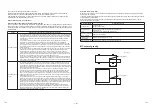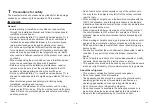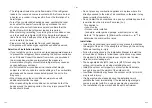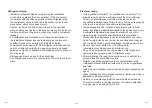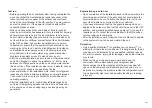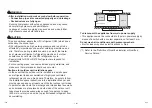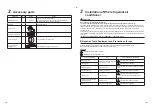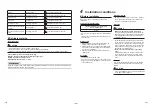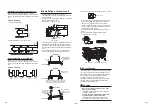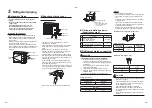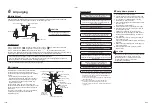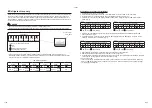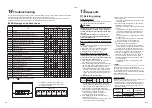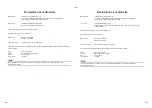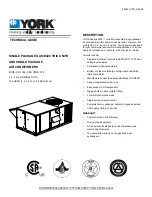
30-EN
29-EN
– 15 –
Vacuum pump
As shown in the
fi
gure, connect the charge hose after
the manifold valve is closed completely.
↓
Attach the connecting port of the charge hose with a
projection to push the valve core (setting pin) to the
charge port of the set.
↓
Open Handle Low fully.
↓
Turn ON the vacuum pump. (*1)
↓
Loosen the
fl
are nut of the packed valve (Gas side)
a little to check that the air passes through. (*2)
↓
Retighten the
fl
are nut.
↓
Execute vacuuming until the compound pressure gauge
indicates –101 kPa (–76 cmHg). (*1)
↓
Close Handle Low completely.
↓
Turn OFF the vacuum pump.
↓
Leave the vacuum pump as it is for 1 or 2 minutes, and
check that the indicator of the compound pressure gauge
does not return.
↓
Open the valve stem or valve handle fully.
(First, at liquid side, then gas side)
↓
Disconnect the charge hose from the charge port.
↓
Tighten the valve and caps of the charge port securely.
*1: Use the vacuum pump, vacuum pump adapter, and gauge
manifold correctly referring to the manuals supplied with
each tool before using them.
Check that the vacuum pump oil is
fi
lled up to the speci
fi
ed
line of the oil gauge.
*2: When air is not charged, check again whether the
connecting port of the discharge hose, which has a
projection to push the valve core, is
fi
rmly connected to the
charge port.
6
Air purging
Airtight test
After completing the refrigerant piping work, perform an airtight test. Connect a nitrogen gas cylinder and
pressurize the pipes with nitrogen gas as follows to conduct the airtight test.
V
L
V
H
Charge port
Low pressure gauge
High pressure gauge
Gauge manifold
Pressure reducing valve
Nitrogen gas
CAUTION
Never use oxygen,
fl
ammable gas,
or noxious gas for the airtight test.
Gas leak check
Step 1....Pressurize to
0.5 MPa
(5 kg/cm²G) for 5 minutes or longer.
Major leaks can be discovered.
Step 2....Pressurize to
1.5 MPa
(15 kg/cm²G) for 5 minutes or longer.
Step 3....Pressurize to
4.15 MPa
(42 kg/cm²G) for 24 hours. ................ Micro leaks can be discovered.
(However, note that when the ambient temperature differs during pressurization and after 24 hours, the pressure
will change by approximately 0.01 MPa (0.1 kg/cm²G) per 1°C, so this should be compensated.)
If the pressure drops in steps 1 through 3, check the connections for leakage.
Check for leaks with foaming liquid, etc., take steps to
fi
x the leaks such as brazing the pipes again and
tightening the
fl
are nuts, and then perform the airtight test again.
* After the airtight test is completed, evacuate the nitrogen gas.
Air purge
With respect to the preservation of the terrestrial
environment, adopt “Vacuum pump” to purge air
(Evacuate air in the connecting pipes) when installing
the unit.
y
Do not discharge the refrigerant gas to the
atmosphere to preserve the terrestrial environment.
y
Use a vacuum pump to discharge the air (nitrogen,
etc.) that remains in the set. If air remains, the
capacity may decrease.
For the vacuum pump, be sure to use one with a
back
fl
ow preventer so that the oil in the pump does not
back
fl
ow into the pipe of the air conditioner when the
pump stops.
(If oil in the vacuum pump is put in an air conditioner
including R32, it may cause trouble with the
refrigeration cycle.)
Compound pressure gauge
Pressure gauge
Gauge manifold valve
Handle High
(Keep fully closed)
Charge hose
(For R32/R410A)
Vacuum pump adapter
for counter
fl
ow
prevention
(For R32/R410A)
Vacuum
pump
Charge port
(Valve core
(Setting pin))
Charge hose
(For R32/R410A)
Handle Low
–101 kPa
(–76 cmHg)
Packed valve at gas side
Pump down process
1. Turn off the Air Conditioner system.
2. Connect the charge hose from the manifold valve
to the service port of the packed valve at gas side.
3. Turn on the Air Conditioner system in cooling
operation more than 10 minutes.
4. Check the operating pressure of the system should
be normal value.
(Ref. with product speci
fi
cation)
5. Release the valve rod cap of both service valves.
6. Use the Hexagon wrench to turning the valve rod
of Liquid side fully close.
(*Make sure no entering air into the system)
7. Continue operate Air Conditioner system until and
the gauge of manifold dropped into the range of
0.5 - 0 kgf/cm²
8. Use the Hexagon wrench to turning the valve rod
of Gas side fully close.
And turn off the Air Conditioner system immediately
thereafter.
9. Remove the gauge manifold from the service port
of the packed valve.
10. Securely tighten the valve rod cap to the both
service valves.
CAUTION
Should be check the compressor operating condition
while pumping down process. It must not any
abnormal sound, more vibration. It is abnormal
condition appears and must turn off the
Air Conditioner immediately.


